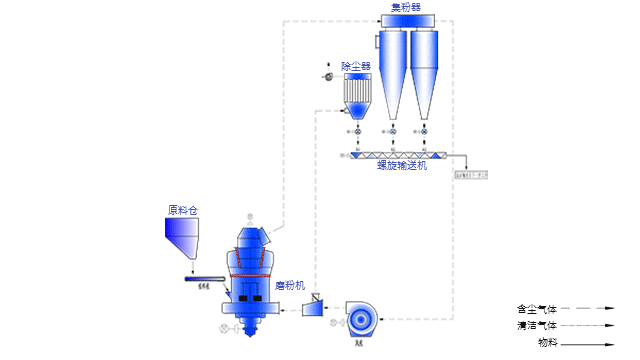Barite is a mineral composed of barium sulfate (BaSO4). It receives its name from the Greek word "barys" which means "heavy." This name is in response to barite's high specific gravity of 4.5, which is exceptional for a nonmetallic mineral. The high specific gravity of barite makes it suitable for a wide range of industrial, medical, and manufacturing uses. Barite also serves as the principal ore of barium.

The big size raw material feed into the raw material hopper by the loader. Under the hopper, the vibrating feeder will feed the raw material into jaw crusher which will crush the big size barite ore into <30mm. The crushed barite ore will be fed into the MTW grinding mill by belt feeder which can be adjust the feeding speed.
The crushed barite will be ground into powder by the roller and ring. The qualified size powder will pass the classifier mixed with the air flow. The oversize powder will fall down and re-grind. The barie powder will be collected by the cyclone and bag filter. The tail gas is purified by the pulse bag filter and then discharged into the atmosphere
The barite powder will be conveyed into the bucket elevator or pneumatic conveying system by screw conveyor. The bucket elevator or pneumatic conveying system will convey the powder into storage silo.
The barite powder will be stocked into the silo and transported by the tank truck. Or the packing machine under the silo will package the barite powder into small packing bag or jumbo bag.
The oil and gas industry is the primary user of barite worldwide. There it is used as a weighting agent in drilling mud. This is a growth industry, as global demand for oil and natural gas has been on a long-term increase.
Most barite produced is used as a weighting agent in drilling muds. These high-density mud
is pumped down the drill stem, exit through the cutting bit and return to the surface
between the drill stem and the wall of the well. This flow of fluid does two things:
1)
it
cools the drill bit;
2) the high-density barite mud suspends the rock cuttings produced
by
the drill and carries them up to the surface.
Drilling-grade barite is produced from commercial barium sulfate-containing ores. The manufacturer shall retain certificates of analysis or similar documentation on these commercial barium sulfate ores. It may be produced from a single ore or a blend of ores and may be a straight-mined product or processed by beneficiation methods, i.e. washing, tabling, jigging or flotation. It may contain accessory minerals in addition to the barium sulfate (BaSO4) mineral. Because of mineral impurities, commercial barite can vary in colour from off-white to grey to red or brown.
Drilling-grade barite shall be deemed to meet the requirements of the International Standard API-13A., the residue greater than 45 micron(5% Min-15% Max).
